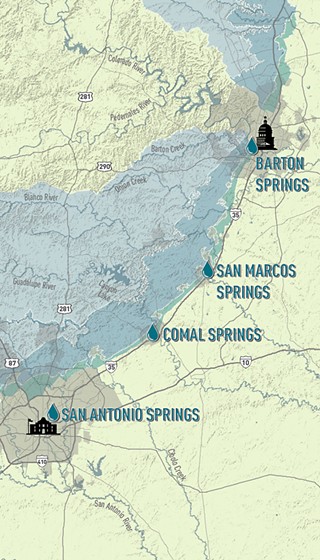Great Springs Project Proposes a Network of Trails From Austin to San Antonio
Written by: Lina Fisher
Read article in the Austin Chronicle
Can one of the fastest-developing regions in the country prioritize conservation? That’s the hope of the ambitious Great Springs Project, which has inched a little closer to realizing its goal of a national parklike trail connecting two of Texas’ most populous cities.
On Dec. 8, the National Park Service selected the Great Springs Project to receive backing in the form of “community planning and technical assistance” for their endeavor to build a network of multiuse trails from Austin to San Antonio. The project proposes adding 50,000 acres of protected land over the Edwards Aquifer recharge zone and portions of the contributing zones in Hays, Travis, Comal, and Bexar counties, as well as connecting hike-and-bike trails to the project’s namesake four bodies of water: Barton Springs, San Marcos Springs, Comal Springs, and San Antonio Springs.
The southeast boundary of the imagined spring-to-spring trail clings closely to the west of I-35 and its northwest boundary spans along Barton Creek, Onion Creek, and the Blanco River down to San Antonio. The legal mechanism by which this land would be protected in perpetuity is called a conservation easement, in which private landowners get tax cuts in return for ceding their right to develop on the land. But typically the land in those cases is not publicly accessible; Great Springs, conversely, wants to encourage public access to the trails and waterways the same way a state park might.

Co-founded in 2018 by Deborah Morin, former board member of the Hill Country Foundation, the project aims to protect endangered species and Hill Country water quality from the increasing development along that corridor, especially in Hays County, one of the fastest-growing counties in the U.S. But Great Springs leadership also contends that it will be an “economic development catalyst,” creating jobs with its ambitious construction.
“We know that more people in Central Texas means we need more places here for those people to live, work, and be outside,” says Emma Lindrose-Siegel, their chief development officer. “For that reason, Great Springs Project works with developers and city and county planners to ensure that the things we love most about living here will be protected and continue to be a resource for future generations.”
The Great Springs Project is still just in its nascency; to get it off the ground, they’ll require large philanthropic donations and probably federal funding, too.
The project is currently in its design stages, so there’s no clear plan yet as to where the trails will go, but Lindrose-Siegel says they will potentially connect to existing trails, making transportation by bike all the way from Austin to San Antonio a possibility. However much this project aims to involve the human communities along I-35, she says that only “a small amount of the total land conserved will have actual trail on it … A priority is protecting the habitat of endangered species endemic to our region.”
So far, Great Springs has made their pitch to former San Antonio Mayor Phil Hardberger, who told the San Antonio Report that the plan is “conceptually” possible, though he worries that the public access part of it could make deals with landowners more difficult to attain. Hill Country landowners might live on their plots and be averse to bike trails crossing through their private land, but there are many different types of easements, and in many cases the landowners benefit from negotiating different uses for the land. For example, Shield Ranch, northwest of Austin, hosts summer camps and partners with TerraPurezza regenerative farm to raise their sheep and pigs on the ranch’s property. Easements like this allow the family that owns the land large tax cuts to be able to keep the homestead in perpetuity, while allowing other uses on other parts of the property – a win-win situation that Great Springs could take advantage of. GSP currently partners with Hill Country Conservancy, Meadows Center for the Environment, San Marcos Greenbelt Alliance, Activate SA, Comal Trails Alliance, and Hill Country Alliance, and Lindrose-Siegel says they do want to “collaborate with … city and county governments and community groups to both amplify their work and unite conservation efforts.”
Great Springs is still just in its nascency; to help get the project off the ground, they’ll require large philanthropic donations, and probably federal dollars, too. The trail planning process is projected to be finished in 2021, but in order to actually break ground, they first need to seek conservation easements and partnerships with land trusts and local, state, and national parks – and, of course, that all-important funding.
